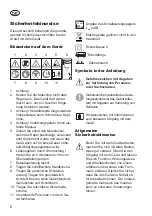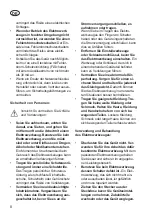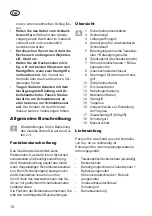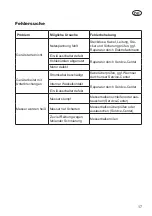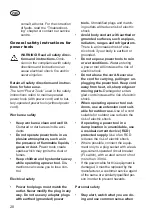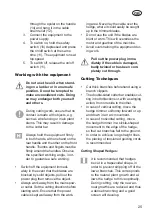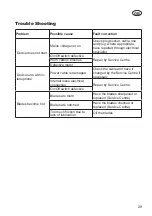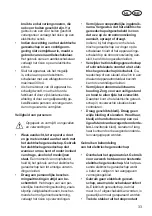
20
GB
consult a doctor. For the correction
of faults, read the “Troubleshoot-
ing” chapter or contact our service
centre.
General safety instructions for
power tools
WARNING! Read all safety direc
-
tions and instructions.
Omis-
sions in the compliance with safety
directions and instructions can
cause electrical shock, fire and/or
severe injuries.
Retain all safety directions and instruc
-
tions for future use.
The term “Power Tools” used in the safety
instructions refers to mains-operated
power tools (with power cord) and to bat-
tery-operated power tools (without power
cord).
Work area safety
•
Keep work area clean and well lit.
Cluttered or dark areas invite acci-
dents.
•
Do not operate power tools in ex
-
plosive atmospheres, such as in
the presence of flammable Iiquids,
gases or dust.
Power tools create
sparks which may ignite the dust or
fumes.
•
Keep children and bystanders away
while operating a power tool.
Dis-
tractions can cause you to lose con-
trol.
Electrical safety
•
Power tool plugs must match the
outlet. Never modify the plug in any
way. Do not use any adapter plugs
with earthed (grounded) power
tools.
Unmodified plugs and match
-
ing outlets will reduce risk of electric
shock
•
Avoid body contact with earthed or
grounded surfaces, such as pipes,
radiators, ranges and refrigerators.
There is an increased risk of elec-
tric shock if your body is earthed or
grounded.
•
Do not expose power tools to rain
or wet conditions.
Water entering
a power tool will increase the risk of
electric shock.
•
Do not abuse the cord. Never use
the cord for carrying, pulling or un
-
plugging the power tool. Keep cord
away from heat, oil, sharp edges or
moving parts.
Damaged or entan-
gled cords increase the risk of electric
shock.
•
When operating a power tool out
-
doors, use an extension cord suit-
able for outdoor use.
Use of a cord
suitable for outdoor use reduces the
risk of electric shock.
•
If operating a power tool in a
damp location is unavoidable, use
a residual current device (RCD)
protected supply.
Use of an RCD
reduces the risk of electric shock.
• Where possible, connect the equip
-
ment only to a plug socket with a leak-
age-current-operated circuit breaker
(FI switch), with a rated current of not
more than 30 mA.
• If the power cable for this equipment is
damaged, it must be replaced by the
manufacturer, a customer service agent
of the same or a similarly qualified per
-
son in order to prevent hazards.
Personal safety
•
Stay alert, watch what you are do
-
ing and use common sense when

